The Apple II personal computer is 35 years old today, a bit of news that I’m sure is either making you feel wildly old or gives you an odd rush of steampunk retro-nostalgia. The computer, launched on April 16 and 17th at the 1977 West Coast Computer Faire, went on to become the definitive machine for primary and high schools everywhere and whose wonky screen and clacky keys brought millions of kids and adults into the information age.
Steve Jobs was 22 when he and Steve Wozniak launched the II. The device, with its eight expansion slots and rapid upgrade cycle, defined the computer as a platform rather than a one-time purchase. You could improve this thing, although I’ve rarely seen any models that were truly tricked out. As Harry McCracken notes, the Apple II and its progeny existed well into the 1990s as a computing solution for many customers.
Not to wax nostalgic, but I still remember typing in long programs into the Apple II and running them just to see them crash and burn because of our sub-par typing skills. A few LIST commands and line edits later and we were up and humming, creating 20 questions simulators and trying to build wonky Spy Hunter clones.
And there was always Oregon Trail. Always.
As I write this, my month old son is panting in his sleep, probably dreaming about something organic and strange. He was been born into a world remade by great men – Jobs, Wozniak, Gates, and Torvalds – who in turn built their castles on the bedrock laid by Bell Labs and the tag team of Richie and Thompson. I still remember the wonder of seeing my first hard-drive powered PC and magic that happened when I went from a Sony Ericsson P900 to my first iPhone. We say technology is all around us, but in a way that’s comforting, at least in the long term.
Kids born in 1975, like me, grew up in a world gently kissed by the promise of technology and then, with the rise of the Apple II and its ilk, we were suddenly swimming in it. I wonder what launched this year that we’ll remember 35 or even ten years from now. Here’s hoping that it’s a technology that will improve our lives in the long run.
